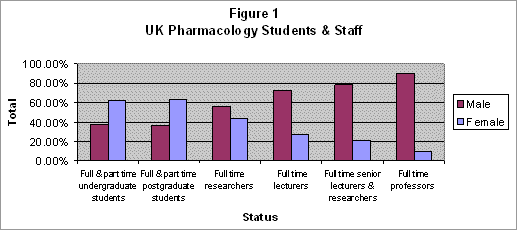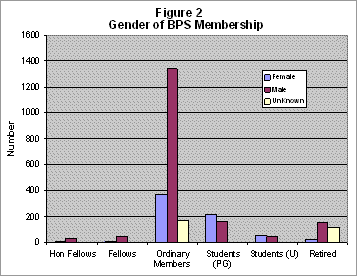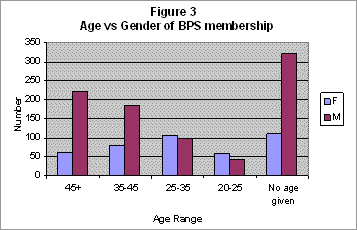Articles from this issue
- The plague of plagiarism
- Pharmacology at University College London
- Neuronal pathways involved in reward and addiction
- A Mentoring Scheme for Female BPS Members
Volumes
Issues
VOLUME 3 - ISSUE 3 - A MENTORING SCHEME FOR FEMALE BPS MEMBERS
In September 2004, representing the BPS, I attended the launch of the UK Resource Centre for Women in science, Engineering and Technology (UKRC)1. This Centre, launched in September 2004, works on a number of different levels to help increase the participation of women in SET. The Centre is funded by the DTI as part of the UK Government’s diversity strategy. At this event I realised that, as a woman, I had been lucky in being able to pursue a reasonably successful and unhindered career in science. In addition I learnt that there are several factors responsible for the mass exodus of women from science at both a national and European level. These facts prompted us, in the Executive Committee, to set up a small working group composed of myself, Prof Sue Brain (KCL), Prof Mandy MacLean (
Like many professional bodies and learned societies, the BPS finds itself with a predominantly male membership; just 28% of the BPS membership is female. Whilst this unbalanced ratio is seen at senior levels in practically all science subjects, it is perhaps more startling when one considers that 63% of undergraduates studying pharmacology, toxicology and pharmacy (PTP) are female. The picture is still well balanced in favour of PTP females at postgraduate level, where 64% of graduate students are female, but by professorship level the number of women has dwindled to just 10%.2

These statistics highlight the fact that something is happening mid-career to prevent women in PTP from fulfilling their scientific potential. There is an argument for suggesting that the high level of female students, both undergraduate and postgraduate, has yet to filter down into the later stages of academic progression. The problem with this view is whether we should wait another 10 years to see if this is the case, and if it isn’t and the pronounced drop-off remains, how will we justify having done nothing?
A closer look at BPS statistics helps us to dissect the situation further. Figure 2 shows that our student membership, has equal proportions of male and female members, but that the profound contrast between the sexes is seen in our ordinary membership upwards, where females make up less than 20% of members.


Figure 3 demonstrates that a steady decline in female numbers is evident as women move through their 20s and 30s and into their mid 40s. This is in contrast with a steady increase in male membership numbers with age. Whilst these figures focus only on the BPS membership, they do point to a problem supported by data from other sources3 of an exodus or leakage at mid-career stage.
The precise reason for this exodus is complex but, as many reports have identified, this is the time of life when many women start to have families and so have to juggle responsibilities at home and work. A lack of part-time and flexible job opportunities in skilled and highly paid work pushes many women into lower skilled jobs and/or a succession of short-term contracts, where their experience and skills are not fully utilised. Alternatively, or as a result of low job satisfaction, women may choose to leave the workforce altogether to focus on their family while their children are young. Once women are on career breaks they can lose touch with developments, lose confidence in their own abilities and, generally, become disconnected with the world of work4. On their return to work they have to compete for jobs with others with full employment records and recent publications, as well as overcoming the prejudiced views of employers who worry that mothers of young children will lack commitment.
We tested out these general observations by sending a short questionnaire to a few female pharmacologists who had left the workplace. We asked why they had decided to leave science and found mixed responses. However, one theme that came through was the perceived inability to be competitive in a profession that uses publication and grant winning as the major indices of success, assessed in four-yearly intervals, with no consideration of time away from work due to such things as childcare. Baroness Green-field describes these issues in ‘The Greenfield Report’ and says that ‘overt discrimination is not the prime factor causing women …to drift away from SET careers. Rather, it is the perception and reality of the workplace, coupled with a systematic set of policies and processes that work together to create a culture that excludes or marginalizes women.’5
To redress this problem there are several things that the BPS can do. One of these is to provide additional support and sources of guidance that women in Pharmacology can draw upon throughout their careers. This, in part, can be achieved with the aid of a mentoring facility. Mentoring is increasingly used in professional and academic situations to offer additional support to under represented groups as a way of helping to break down segregation at work. Mentoring can be seen as a form of training, encouragement and career counselling offered to the minority group (in this case women) to help them access opportunities that are normally denied to them or enabling them to participate in areas of the workforce where they are proven to be under represented. Such activities are supported by the Sex Discrimination Act (1975), which sets out the case for ‘positive action’6.
Mentoring has been found to have the following benefits for professional women: - by connecting women through mentoring partnerships and women’s networks it helps to address feelings of isolation that come through working in male dominated environments In light of the above benefits the BPS, with the help, guidance and financial aid of the UKRC, which can offer specialist advice on mentoring for women, has decided to pilot a mentoring scheme as a first step in tackling the gender gap in our Society. Several universities in the UK have active mentoring schemes both specifically for women and for both genders. However, these schemes ultimately use the staff within that university as the resource for both mentors and mentees. A common perceived difficulty with in-house mentoring schemes is the issue of matching of individuals that enables open and frank dialogue. By providing a scheme via the BPS it should be possible to match mentees with mentors who are experienced in the issues facing young female pharmacologists, but from different institutions. This inter-employer approach will bring flexibility, openness and diversity, creating a rich network for the women involved. Indeed the UKRC has been running such a scheme, very successfully, for the Institute of Civil Engineers since May 2003. This scheme has linked over 60 female engineers in universities, industry and public sector organisations and has been well received by the participants and the Institution. For more information about this and other schemes run by the Resource Centre see the mentoring sectoring section of the Centre’s website at www.setwomenresource.org,uk. As many of you may already be aware the BPS has sent out a call for women who might be interested in participating in a BPS mentoring scheme, and I am happy to say that there has been a very good response. The Executive Committee, in partnership with the Resource Centre, has decided to target the scheme at women who are completing their PhD or who have a PhD and are in the early stages of their career. We intend to set up at least 10 mentee/mentor pairs, to train these individuals in the process and then let the scheme run for the year. This will give us sufficient time to determine whether the scheme is of any real benefit to our membership. At the end of the year we will make an in-depth analysis of the scheme from all perspectives. On the basis of our findings the Executive Committee and Council will be in a position to determine whether the BPS wishes to commit continued resource to this scheme or not, but also to consider whether the scheme might be available to all BPS members both male and female. Dr Amrita Ahluwalia References 1. for more information about the UKRC see www.setwomenresource.org.uk
- female mentors can often talk with personal experience about the difficulties of juggling responsibilities at work and at home
- mentors can act as a role model
- mentors can be a general source of advice, contacts, and professional friendship
- women who participate in mentoring report an increase in confidence, motivation, and knowledge of their company/industry/profession
- both mentors and mentees report an increase in useful transferable skills such as communication, giving feedback, setting objectives, and listening
Queen Mary & Westfield College
2. Students statistics taken from HESA Students in Higher Education Institutions 2003/04, all other statistics taken from HESA Resources of Higher Education Institutions 2002/03
3. See statistics section of UKRC website for more data, e.g. gender break down of beneficiaries of BBSRC funding and holders of BBSRC Fellowships
4. See ‘Issues for Returners in the 21 st Century’ www.women-returners.co.uk
5. Baroness Susan Greenfield ‘SET Fair: A report on women in science, en-gineering and technology’ Nov 2002, DTI, see online article
6. see the Equal Opportunities Commission website
